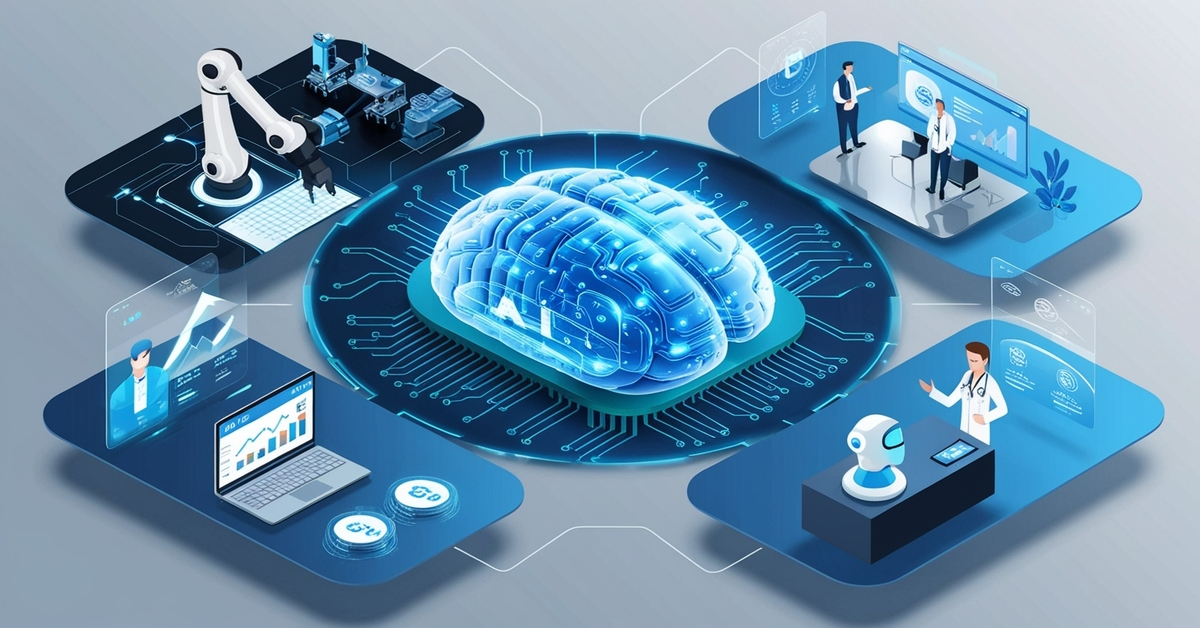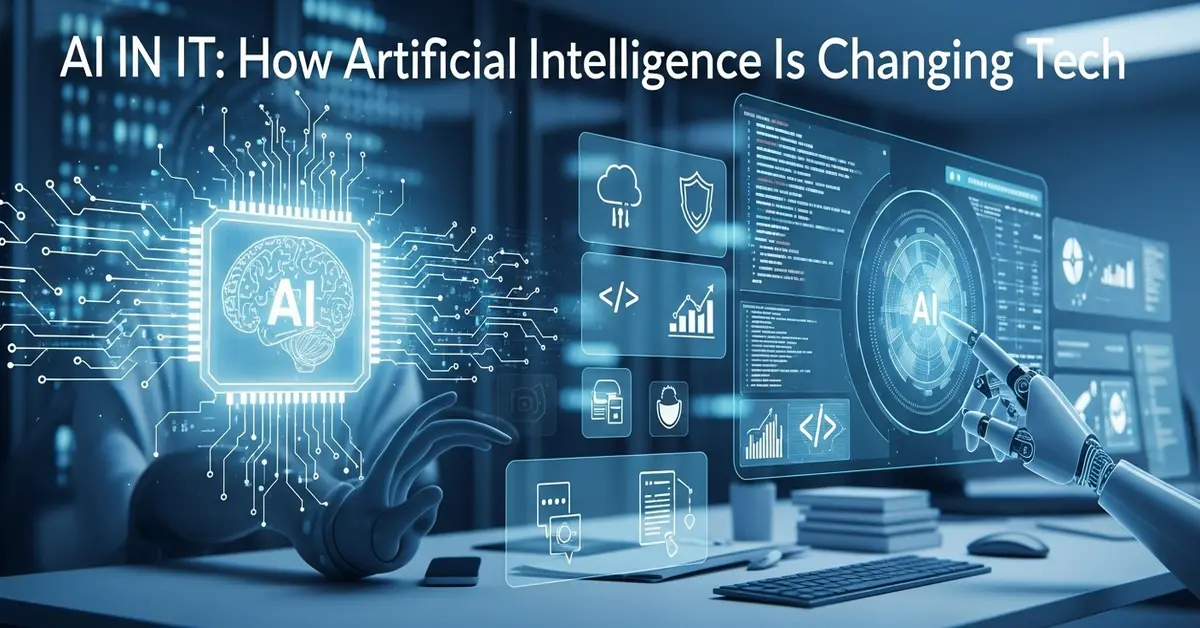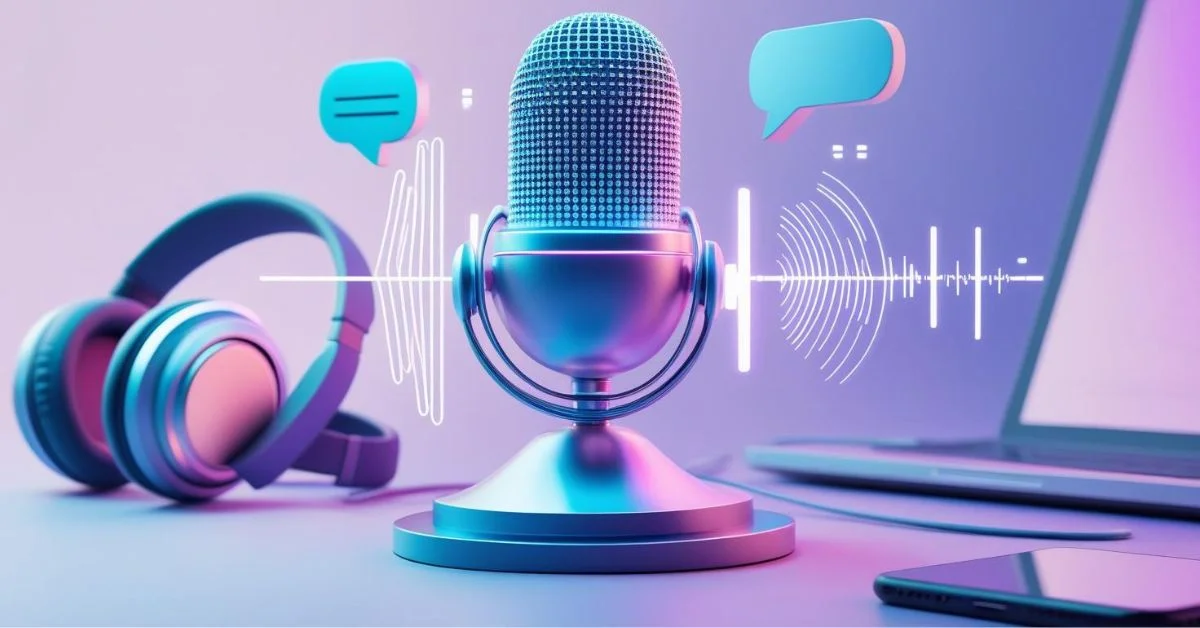AI has moved beyond being just a trendy term. In 2025, it plays a major role in transforming how industries work. From automating routine tasks to enabling agents that act independently, AI is changing how businesses operate, how workers perform, and how society adapts. In this article, we’ll explore key trends driving AI adoption across sectors, including:
- Agentic AI and autonomous agents
- Generative AI in creative and software development
- Industrial AI and robotics
- Intelligent automation in enterprises
- Healthcare, finance, insurance, retail, and BPO are all changing quickly thanks to the power of AI.
- Environmental challenges and green AI
- Regulation, governance, and global investments
Let’s dive into each trend, explain it in simple daily words, and see how it’s already making a difference in the real world.
What is Agentic AI?
Agentic AI refers to systems or “AI agents” that can work on tasks by themselves. They don’t just wait for someone to ask them; they sense what’s going on, make decisions, learn from mistakes, and adjust. It’s like having a junior employee who needs little supervision and gets better with each task
Why does it matter in 2025?
AI has moved past simple chatbots. Now, agents can write code, book meetings, monitor systems, and fight cyber threats all without step-by-step instructions.
Real-world uses today
- Software coding: Agents draft code from plain English, fix errors, and suggest improvements.
- Customer support: Instead of basic FAQ bots, new agents handle problems end-to-end, escalating only when needed.
- Industrial maintenance: Factories use sensors and agents to predict when machines need service, cutting unexpected downtime
- Financial trading: AI agents trade stocks in fractions of a second, making their own decisions faster than humans
What’s driving this shift?
Advances in:
- Reinforcement learning: With reinforcement learning, AI systems improve by making mistakes and learning what works through experience.
- Multimodal learning: They see images, hear audio, and read text together
- Large language models (LLMs): These power smart communication and reasoning
Generative AI: from art to code
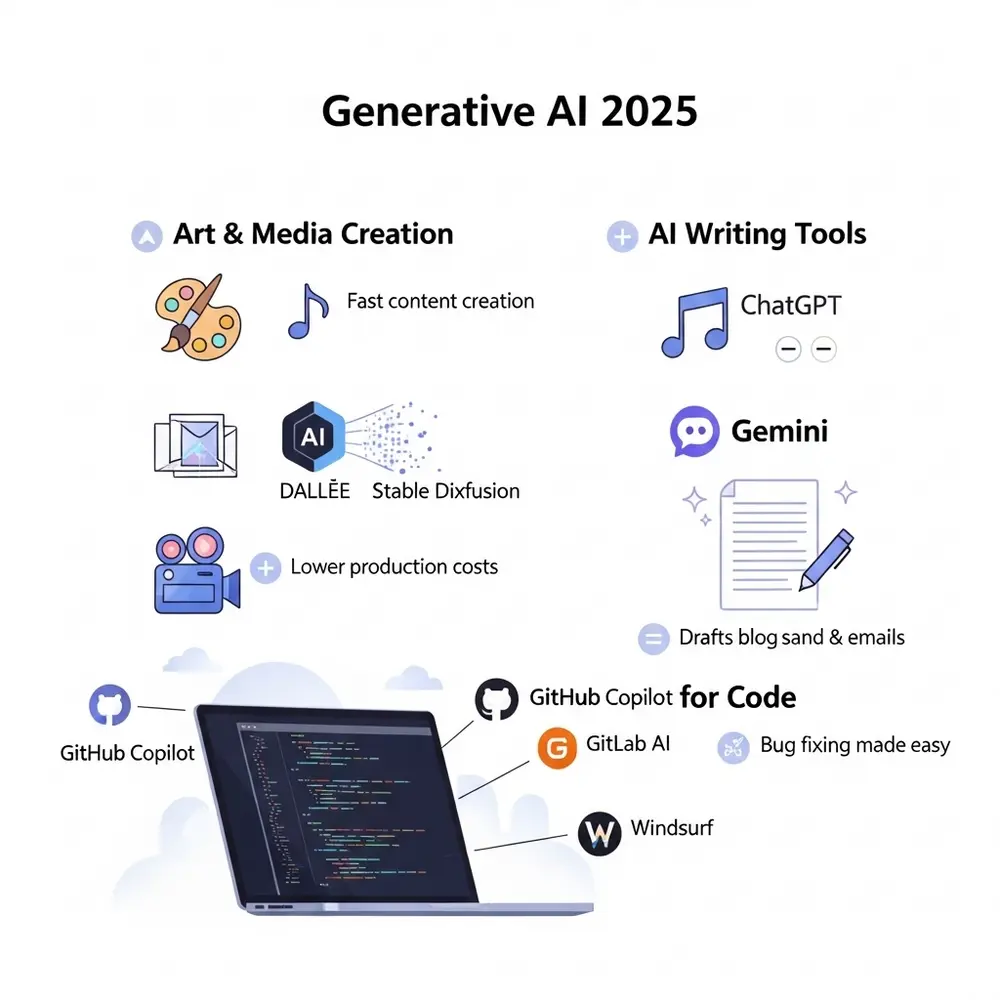
Generative AI refers to tools that can create: text, images, music, videos, and even computer code. 2025 has been a breakthrough year:
1. Creative industries go turbo
AI tools like DALL·E, Stable Diffusion, and new systems are generating high-quality images, animations, and music on demand. Advertising, video editing, and design have become faster and more accessible
Pros
- Anyone can make visuals or content on the fly.
- Production cycles are much faster.
- Lower cost for small businesses and creators.
Cons
- Ethical concerns around deepfakes and copyrighted work.
- Jobs in modelling, photography, and design are shifting
2. AI writing assistants reshape workflows
Tools like ChatGPT or Gemini help write reports, emails, blog posts. In 2025:
- Writers, marketers, and legal teams are using these tools to draft and revise.
- They work alongside humans, not replace them entirely
3. AI for code
Developers can now code and fix errors more efficiently using AI tools such as GitHub Copilot, GitLab AI, and Windsurf. Google’s acquisition of Windsurf highlights this trend. These tools:
- Generate code from plain English.
- Catch bugs and suggest fixes.
- Free developers for creative problem solving .
Industrial AI and robotics: smarter factories
In 2025, AI isn’t just digital, it’s physical too.
1. Smart factories
Manufacturing plants now use AI-powered robots and digital twins. These systems can:
- Monitor equipment and predict failures.
- Adapt to changing production needs.
- Collaborate with humans on assembly lines.
2. Cobots (collaborative robots)
Cobots, unlike older factory robots, are made to safely collaborate and work directly with human workers. They can be reprogrammed easily, making small batch production affordable.
3. Edge computing
With data processed right where it’s created on the factory floor, AI agents make faster, smarter decisions in real time
4. Maglev conveyors
New systems like AI-powered maglev conveyors use floating belts to move items faster, quieter, and with less energy than traditional conveyors
Intelligent automation in businesses
Business Process Outsourcing (BPO), insurance, real estate, government services they’re all embracing intelligent automation.
1. BPO reborn
TCS’s CEO notes BPO companies are shifting from repetitive call center tasks to AI enhanced services. Agents can analyze calls, automate responses, and escalate only premium issues.
2. Insurance
Insurers use AI for underwriting, claims processing, fraud detection. While these bring speed and accuracy, they also raise concerns about fairness and regulation.
3. Real estate
Startups like Voqo in Australia use AI bots to handle calls, qualify leads day and night, reducing missed sales opportunities.
4. Government
Public sector agencies deploy AI agents to assist citizens, answer questions round the clock, and manage complex data like climate risk .
Sector-specific shifts
1. Healthcare
AI is helping doctors diagnose images faster, plan treatment, and predicting health risks. Chatbots also help patients with basic medical queries though oversight remains essential.
2. Finance and banking
AI models detect fraud, personalize investments, and even trade automatically. Firms like JPMorgan use algorithmic trading bots .
3. Retail and customer experience
Stores use AI for virtual Tyron’s, smart recommendations, and inventory management. Physical retailers are merging online and offline shopping with AI.
4. Real estate again
As earlier mentioned, intelligent bots and AI driven workflows are cutting costs and increasing efficiency.
Workforce: jobs are reshaped not just lost
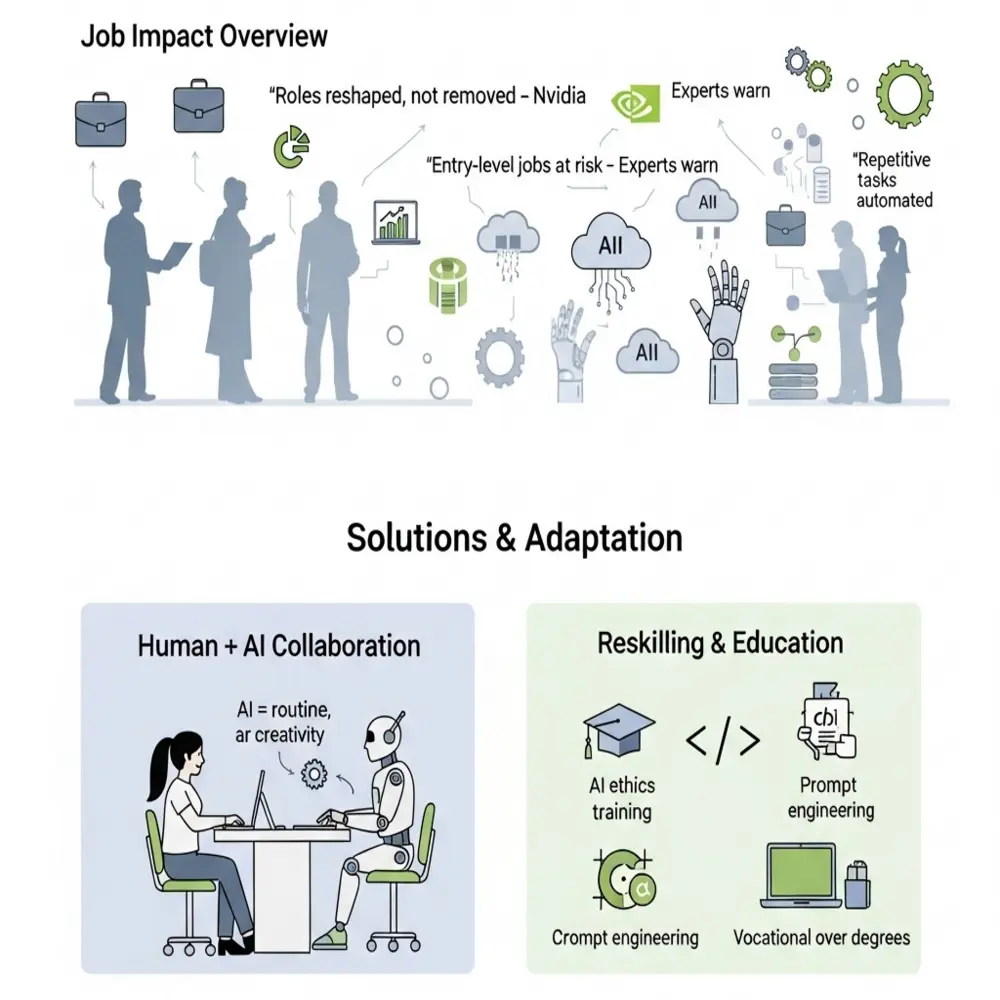
The impact on jobs is a big story in 2025:
- Tech leaders like Nvidia’s Jensen Huang say AI is going to reshape roles, not eliminate all jobs.
- Warning voices like Sam Altman, Hinton, and Dorr caution that many jobs especially entry level white collar roles are at risk.
- Reality check: job displacement is happening, especially for repetitive tasks in law, finance, marketing, and low level engineering.
1. Human+AI collaboration
The trend is toward augmenting workers:
- Humans handle exceptions and creativity.
- AI handles data and routine.
2. The reskilling mission
Companies and governments are investing in retraining:
- Upskilling for AI oversight roles.
- Training in prompt design, AI prompting, AI ethics.
- Emphasis on vocational education not just college degrees.
Environmental and energy challenges
AI consumes a lot of power
- Training large models can generate hundreds of millions of dollars in computing cost and tons of CO₂ emissions.
- However, inference (using the model) is becoming cheaper and more efficient .
Still, the global push is on for green AI
- Nuclear powered data centers (like Microsoft’s Three Mile Island project).
- Energy efficiency & smart infrastructure.
- AI monitoring energy use to reduce waste.
Chips, cloud, and infrastructure
AI demands more specialized hardware and cloud services:
- Custom silico: Application specific chips (ASICs) and AI optimized processors outperform general GPUs for certain tasks.
- Hyperscale cloud: Major providers (AWS, Azure, Google Cloud) now offer AI tailored chips, optimized workloads, and agentic AI platforms .
- Edge AI: Smaller devices process AI locally, reducing delays and protecting privacy .
Regulation, governance, and global action
AI’s power has drawn global attention
- Global summits: The 2025 Paris AI Action Summit in February gathered leaders from 100+ countries to discuss investment and regulation
- National laws: In the U.S., new bills on deepfakes and synthetic content have lawmaker attention
- International efforts: BRICS proposed UN led AI governance to ensure fair access and oversight.
- Startup growth: Many region-specific AI pilots from insurance to real estate are getting early funding .
Ethical AI, bias, and trust
As AI spreads, fairness and transparency become critical:
- Papers on explainable AI (XAI) are growing; systems now record why they made decisions.
- Concerns about algorithmic bias, especially in insurance and hiring, prompt calls for regulation.
Identity loss and manipulation from deep fakes accelerates policy efforts .
The road ahead: What to watch
- Hybrid teams: People + AI will become the norm, with clear roles and collaboration.
- AI in everyday life: From virtual Tryon’s to medical triage, AI will become invisible yet essential.
- Education shift: Learning to work with AI prompt design, data literacy, ethics becomes the new basic.
- Stronger global frameworks: Countries and alliances must craft AI standards for safety and fairness.
- Sustainability: Innovations in energy and compute will define AI’s long term future.
In closing
AI in 2025 is no longer a novelty it’s a toolkit, a teammate, and a challenge. Each industry is being transformed, from how machines work to how we make decisions. But it also brings responsibility: we must design fair, safe, sustainable systems and prepare people for new roles. If you’re in business, policy, or simply curious, these trends show not only what AI can do, but what it should do. The next chapter is about balance: harnessing AI’s power while ensuring it serves humanity responsibly.
